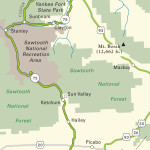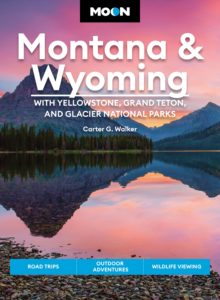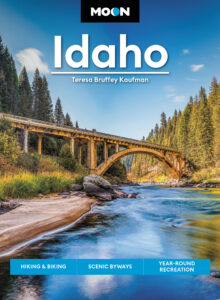Shoshone and Minidoka
Shoshone
South of the Sun Valley area, Hwy-75 runs across 60 miles of south-central Idaho’s rocky black lava flows. Halfway between Sun Valley and Twin Falls, 16 miles north of the town of Shoshone, the Shoshone Ice Caves (208/886-2058, daily May-Sept., $10) present a series of lava tubes developed into a low-key tourist trap. Just west of the highway, their constant cool temperatures make a pleasant contrast to the often-scorching summer heat. (The “ice” in the name is created by air currents flowing through the tubes, causing subterranean water to freeze.) The only way to explore the caves is through guided tours, which take about 45 minutes. The gift shop and mineral museum, which features lava rocks and local wildlife, will satisfy anyone’s needs for tourist-trap trash (and I mean that in the best possible way).
Just down the road, Mammoth Cave (208/886-7072, daily summer, $10) is much more basic and undeveloped.
The only town along this stretch of road, Shoshone (pop. 1,511) is a ranching and railroad center that marks the junction of Hwy-75 with US-93. Some of its buildings have been constructed from local volcanic rock. Though it’s a fairly timeworn place, Shoshone looks great at sunset, when its steel water tower glows and places like the neon-signed Manhattan Café (208/886-2142) on the south side of the railroad tracks look especially appealing.
Minidoka Internment National Historic Site
Between Shoshone and Twin Falls, the potato-growing Snake River plains hold a surprising remnant of a moment in time many Americans would just as soon forget: the forcible arrest and deportation of over 110,000 Americans of Japanese descent during the early 1940s. Moved from their homes in California, Washington, and Oregon, entire families were uprooted and relocated to desolate, middle-of-nowhere places where they were made to live in makeshift shacks. Here at Minidoka National Historic Site, 19 miles northeast of Twin Falls, more than 10,000 American citizens were held as prisoners between 1942 and the end of World War II three years later. The 73-acre site preserves a handful of buildings, including the guardhouse, but it’s the isolation that endures most. The site has no services and can be hard to reach; head east from US-93 along Hwy-25 for 9.5 miles, then north along Hunt Road for another 2.5 miles. The visitors center is 40 miles away in Hagerman, on US-25.
Related Travel Guides
Map of the Border to Border Route through Idaho

















